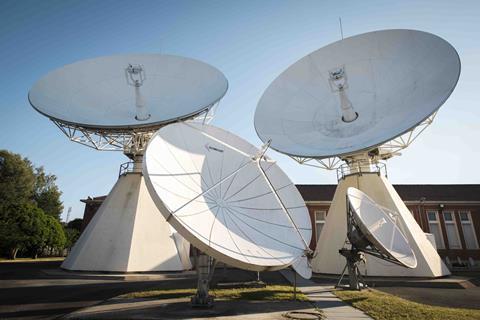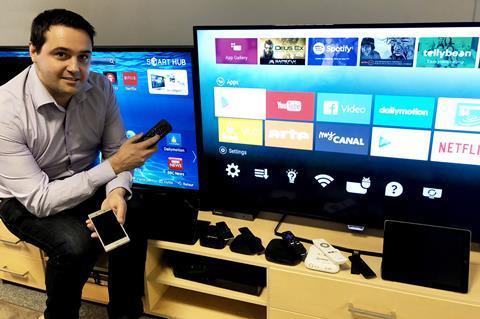An ever-escalating number of services and the high bandwidth requirements of UHD are among the developments driving the use of satellite to deliver OTT content, discovers David Davies.

With the number of broadcasters looking to introduce OTT services – either augmenting existing linear programming or constituting fresh new forms of content – rising all the time, it’s not surprising that the method of delivering them has become an increasingly hot topic. The availability of high-speed internet still not a given, even in some of the most mature markets, so the concept of ‘hybrid delivery’ that uses existing satellite capacity to deliver new OTT services has begun to gain significant traction.
The SAT>IP Alliance represents a group of companies keen to promote the use of the SAT>IP protocol that enables satellite TV signals to be converted to IP streams. Alliance president Thomas Wrede – who is also vice-president, new technology & standards at satellite and ground communications operator SES – remarks: “The growing trend for high quality content and viewing that content across several devices in a household is placing a huge strain on internet speeds and can often result in a poor quality viewing experience. Innovation in satellite delivery, such as SAT>IP, enables advanced, multi-screen services – even in locations where broadband is not reliable enough to handle live, high-definition video.”

Wrede also believes hybrid delivery holds the promise of bold new services and revenue streams (no pun intended). “Converting a satellite TV signal to an IP stream also opens up the potential for new and innovative revenue models, offering the opportunity to develop and launch new services,” he says. “Integrating satellite with OTT to create a hybrid service takes the best part of satellite delivery (high quality, guaranteed delivery) and combines the flexibility and personalisation of IP experiences.”
- Read more: The broadcaster’s OTT conundrum
‘Satellite is back’
Among both satellite and technology providers, the impression at present is of something of an explosion of new creativity. Proclaiming on its website the belief that “satellite is back”, Broadpeak is evidently in favour of the new hybrid era. To this end it has developed a number of solutions geared towards making “your satellite network the perfect infrastructure to deliver OTT content to any screen”.

Broadpeak product manager Damien Sterkers confirms that whilst awareness of hybrid’s possibilities is “growing generally”, it can still be a matter of some variation. “In some cases, it can be a matter of finding the right vocabulary”, he suggests, in order to most effectively describe the service opportunities that hybrid opens up.
As most companies active in this space would concur, it is live sport and other premium live events that currently constitute the primary driver of growth here. They have certainly helped to propel Broadpeak’s own nanoCDN solution forward. In essence, nanoCDN employs multicast ABR (adaptive bit-rate) to bring satellite-delivered content to multiple screens and devices throughout a household. The ability to maintain the highest possible bit-rates and preserve broadcast QoE with regard to low latency and zapping time are among the stated benefits of nanoCDN.
As the volume and diversity of content increases, Sterkers believes the need for close collaboration between content owners and network operators – of whatever type – will become more acute. “People will realise how important ‘the pipe’ is,” he believes. “The relationship between [those two groups] will be crucial so the content owner can decide on the quality of delivery needed in a manner that is as seamless as possible.”
“People will realise how important the pipe is”
Ultimately, it might be ideal if “some form of automation could be introduced into the process so that there is no need for a dedicated contract for each project. It will be fascinating to see how this develops in the future.”
‘We can pick and choose’
Content playout, distribution and contribution company Globecast occupies an interesting position in the market because it is not linked to any specific satellite operator (it rents space as required) or CDN provider. “Hence we can pick and choose for each of our customers on the basis of what is the right solution for them,” says Denis Genevois, VP marketing & business development for broadcasters, Globecast. “For us, it is mostly a question of how to allow our customers to enable their business in a cost-effective way. The technology itself brings with it a cost – and so, of course, does the content.”

Consequently, the nature and volume of the intended service has a significant impact on the method of delivery that is selected. But a few generalisations can be made – not least the fact that “satellite has a real and important role to play in the delivery of UHD due to its bandwidth requirements”.
Whilst Serkers highlights the possibility of greater automation determining delivery, Genevois notes the rise in interest for managed services that encompass “what we call content preparation as well as delivery in the hybrid form, either over satellite or the internet.” These have resonated with content providers who “do not want to take care of the technical side”; one can only presume they will increase in number as the quantity of content they are expected to produce continues to grow.
‘Cornerstone of our portfolio’

Deepak Mathur, EVP of global sales at SES Video, believes there are sound technological and business reasons for hybrid services to be in favour. “For OTT, now that there are robust terrestrial alternatives in place to deliver the return path, satellite’s ability to routinely deliver high bandwidth signals without network congestion is becoming increasingly recognised, especially as UHD content becomes an increasingly important differentiator. Using satellite to deliver a VOD-like experience without the need for high-speed broadband connectivity is also something that appeals to our customers as they see the value in differentiating themselves and staying relevant to a younger audience.”
“Satellite’s ability to routinely deliver high bandwidth signals without network congestion is becoming increasingly recognized”
Along with “the bandwidth requirements of UHD”, Mathur pinpoints the growing importance of latency as live OTT services become more ubiquitous. “Latency is going to be an increasing issue too, especially as OTT services pivot increasingly towards offering live content, especially sports,” he says. “Satellite delivery has far less latency inherent in the signal – an important consideration when people are following major sporting events via television and social media at the same time.”
Prioritising partnerships
Further reinforcing the emphasis on partnership made by all contributors to this article, Mathur reveals details of a newly agreed collaboration with Nowtilus, which is a provider of targeted dynamic in-stream ad insertion solutions. “‘We’ve combined Nowtilus’ innovative, cloud-native, server-side ad insertion (SSAI) technology with our global media services for broadcasters, TV networks and OTT service providers, creating an end-to-end solution that brings personalised TV and targeted advertising services to big screens and mobile devices in broadcast-grade quality. The targeted and dynamic ad insertion solution enables service providers to increase ad revenues with their live TV and VOD content.”
The creative and business opportunities of hybrid services mean that prioritising partnerships is sure to be critical in the future. With the demand for high-quality OTT services only heading in one direction, all stakeholders will need to work together closely to ensure both the content and the means of delivery remain truly fit for purpose.














![Adeline Platform Help[64]](https://d3dh6of9cnaq4t.cloudfront.net/Pictures/100x67/0/6/9/30069_adelineplatformhelp64_996092_crop.png)









No comments yet